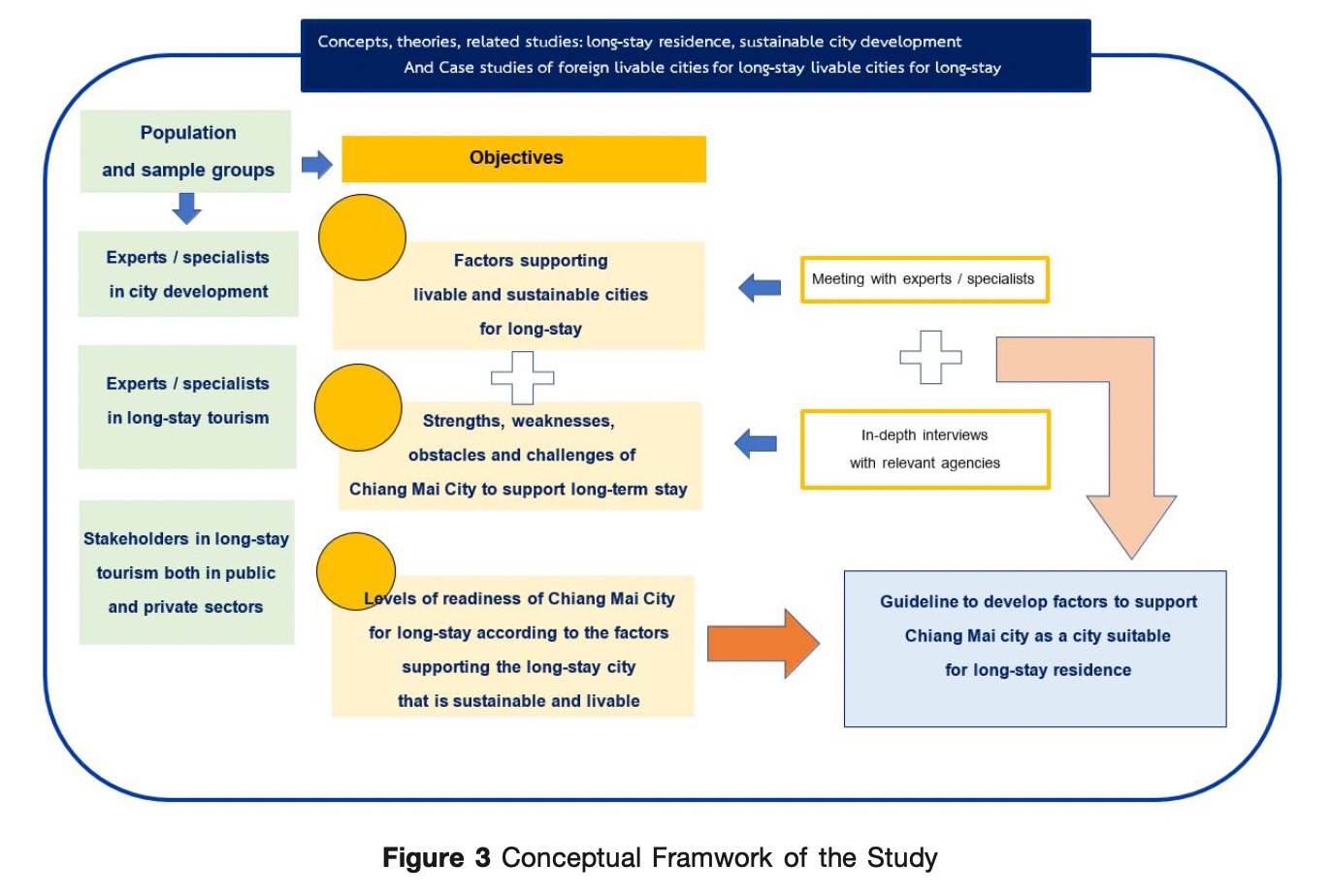Readiness Factors of Chiang Mai City to Support Sustainable and Livable City Long-Stay Tourism
Main Article Content
Abstract
In Thailand, both the public and private sectors have focused extensively on a policy of long-stay tourism as a channel for development. Such a policy aims to encourage capability of service and quality of physical factors that could support foreign long-stay tourists in Thailand. Chiang Mai is one of the cities in Thailand that pays particular attention to support long-stay tourism, as the city has the largest number of a long-stay tourists in Northern Thailand. This study examined readiness factors of Chiang Mai City that could support sustainable and livable long-stay tourism and proposed guidelines for improvement. The research tools were in-depth interviews and brainstorming discussions with key experts and stakeholders. The research identified 17 potential factors that could support Chiang Mai’s effort to be a long-stay city, but only 4 factors were confirmed to be at a high level of readiness. These 4 factors consisted of 1) effective disaster management system, 2) basic and sufficient elements to serve long-stay tourists, 3) cultural heritage preservation that illustrates a history and understanding of the traditional way of life, and 4) reasonable and affordable cost of living. This study also proposed some concrete preparedness guidelines for Chiang Mai City to support the transition to a sustainable and livable long-stay city.
Downloads
Article Details

This work is licensed under a Creative Commons Attribution-NonCommercial-NoDerivatives 4.0 International License.
All material is licensed under the terms of the Creative Commons Attribution 4.0 International (CC-BY-NC-ND 4.0) License, unless otherwise stated. As such, authors are free to share, copy, and redistribute the material in any medium or format. The authors must give appropriate credit, provide a link to the license, and indicate if changes were made. The authors may do so in any reasonable manner, but not in any way that suggests the licensor endorses you or your use. The authors may not use the material for commercial purposes. If the authors remix, transform, or build upon the material, they may not distribute the modified material, unless permission is obtained from JARS. Final, accepted versions of the paper may be posted on third party repositories, provided appropriate acknowledgement to the original source is clearly noted.
References
Balsas, Carlos J.L. (2004). Measuring the livability of an urban centre: An exploratory study of key performance indicators. Planning, Practice & Research, 19(1), 101-110.
Buranasiri, P. (2011). Chumchon nā yū [Livable city]. http://52010119156g7.blogspot.com/2012/04/blog-post.html
Center of Tourism Research and Development. (2018). Long stay tourism development strategic plan in the upper northern, Thailand. Chiang Mai University.
Charoernmuang, D. A. (2002). Sustainable cities in Asia: Chiang Mai: Concepts and experiences of Nara and Bali. Social Research Institute, Chiang Mai University.
Charoernmuang, D. A. (2002). Sustainable city: Concepts and experiences of the West. Social Research Institute, Chiang Mai University.
Haughton, G., & Hunter, C. (1994). Sustainable cities. Jessica Kingsley.
Intaratat, K. (2006). Thailand’s potential for long-stay tourism. School of Communication Arts, Sukhothai Thammathirat University.
Kampanatsaenyakorn, C. (1995). Livable city. Rungruangsarn Press.
Kotler, P., Bowen, J.T. & Makens, J.C. (2006). Marketing for hospitality and tourism (4th ed.). Prentice-Hall.
McGee, T. G. (2010). Building liveable cities in Asia in the twenty–first century research and policy challenges for the urban future of Asia. Malaysian Journal of Environmental Management, 11(1), 14-28.
Munasinghe, M. (1993). Environment economics and sustainable development. World Bank.
National Science Technology and Innovation Policy Office. (2017). From innovation to sustainable industrialization. http://www.sti.or.th/sti/news-detail.php?news_type=1&news_id=189&
Office of the National Economic and Social Development Council. (2012). Country strategy. Office of the Prime Minister.
Paul, A., & Sen, J. (2020). A critical review of liveability approaches and their dimensions. Geoforum, 117, 90-92.
Sangkakorn, K. (2013). Kān thǭng thīaw pamnak raya yāw [Long stay tourism] [PowerPoint slides]. SlideShare. https://www.slideshare.net/amicsangkakorn/long-stay-22271578
Sangkakorn, K. (2017). Long stay master plan in 2017 - 2021 of the upper Northern Provinces 1. Ministry of Tourism and Sports.
Srethasirote, B. (2013). Research and public forum project Towards Rio+20 Meeting: Trends and implications to Thai society. Thammasat University.
Tan, K. G., Woo, W. T., & Tan, B. S. (2014). A new instrument to promote knowledge-led growth: The global liveable cities index. International Journal of Business Competition and Growth, 3(3), 174-188.
Thadaniti, S. (2007). Application of concept and master plans for urban and community livable development. Social Research Institute, Chulalongkorn University.
The Malaysia Administrative Modernization and Management Planning Unit. (2021). MM2H Programme. https://www.malaysia.gov.my/portal/subcategory/865
The Thai Real Estate Association. (2020). Acceptance of special types of tourists. http://thairealestate.org/content/detail/
United Nations in Thailand. (2015). Sustainable development goals. https://www.un.org/sustainabledevelopment/sustainable-development-goals/
Worldwide Travel Visa Guide. (2021). Complete guide to obtaining a visa to retire in Indonesia. https://visaguide.world/asia/indonesia-visa/retirement


